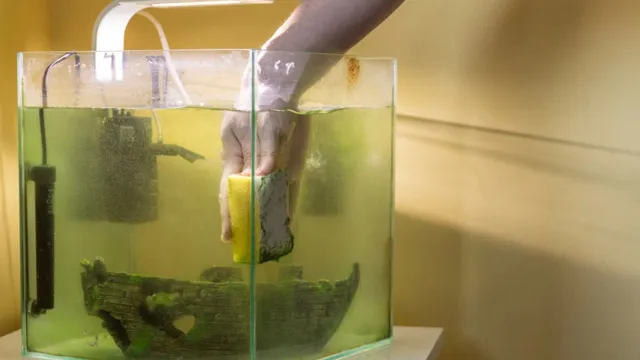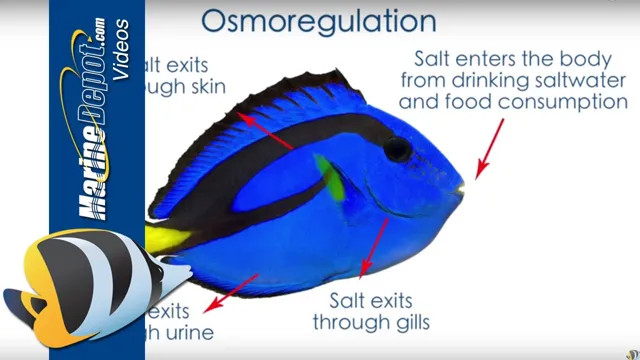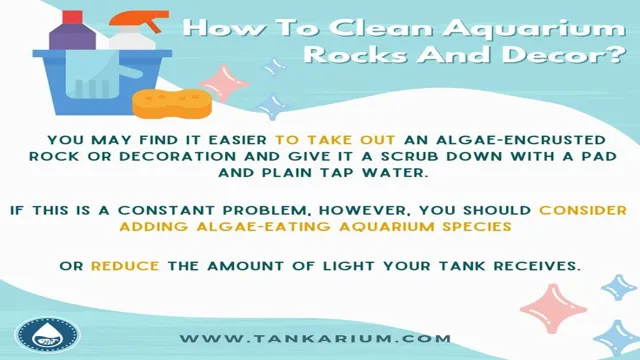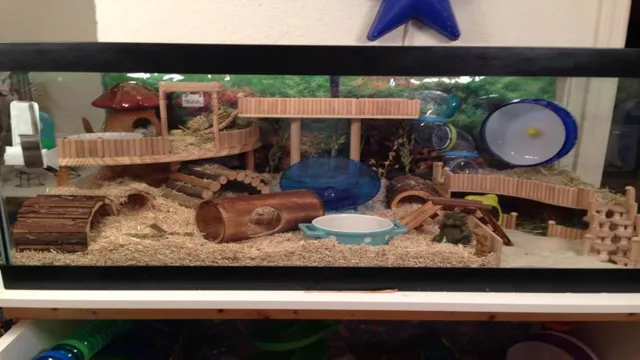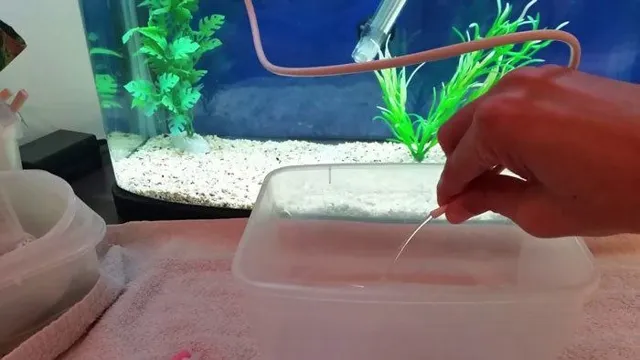Aquariums have become a popular way to keep fish and other aquatic creatures in your own home. They provide a glimpse into the underwater world, but with great beauty comes great responsibility. One of the most important tasks of maintaining an aquarium is cleaning the walls.
You want to ensure that the view is always crystal clear for both the fish and the viewers. But how do you clean aquarium walls without harming its inhabitants or damaging the aquarium surface? In this blog post, we will guide you on how to clean your aquarium walls effectively and safely, so you can keep enjoying the stunning view without any worries. So, let’s dive in!
What You Need
If you’re a proud aquarium owner, then you know how important it is to keep the walls of your aquarium clean. This not only ensures that your aquatic pets have a safe and healthy environment to live in, but it also keeps the tank looking nice and clear. To clean aquarium walls, you need a few key tools.
First, a magnetic algae scraper is essential. This tool allows you to clean the walls of your aquarium without getting your hands wet. Simply attach the scraper to the inside of the tank and move it back and forth to remove any algae or built-up debris.
Additionally, a small bucket or container is also necessary to hold the water that you’ll be using to clean. Finally, make sure that you have a siphon hose to remove debris and water from the bottom of the tank as you clean. By having these tools on hand, you’ll be able to keep the walls of your aquarium clean and your fish healthy.
Magnetic Algae Scraper
If you’re an aquarium enthusiast, you know how challenging it can be to keep your tank algae-free. But don’t worry, we have the perfect solution – a magnetic algae scraper! To use this handy device, you’ll need just a few things. First, make sure your aquarium glass is clean.
Then, grab the algae scraper and attach the two magnetic sides to either end of the glass, ensuring that the scrubbing surface is facing the algae. Once they’re in place, gently move the algae scraper along the glass to remove any algae buildup. That’s it! The magnetic algae scraper is a game-changer when it comes to cleaning your aquarium, and with just a little bit of effort, you can maintain a clean and healthy environment for your aquatic pets.
Keyword: Magnetic Algae Scraper.
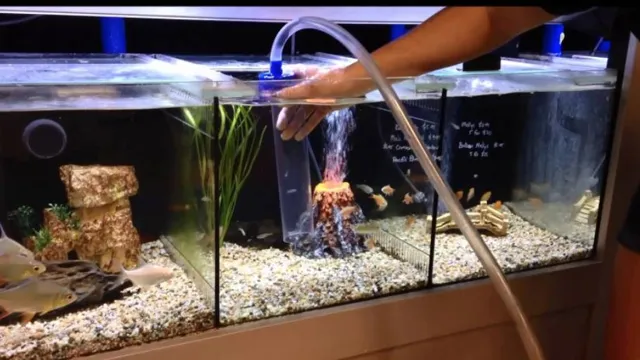
Algae Pads and Sponges
If you want to keep your aquarium or fish tank clean and healthy, you might want to consider using algae pads and sponges. But what do you need to get started? Well, first of all, you’ll need the right size and type of pad or sponge for your tank. Algae pads come in various sizes, and you’ll want to get one that’s appropriate for your tank’s size.
Similarly, there are various types of sponge filters, and you’ll want to choose the right one based on the type of filtration you need and the size of your tank. You’ll also need to make sure you have a regular cleaning and maintenance routine in place to ensure your algae pads and sponges continue to work effectively. And don’t forget to replace them as necessary, as dirty or worn-out pads and sponges won’t do their job properly.
With the right supplies and a bit of care, algae pads and sponges can help keep your aquarium or fish tank healthy and beautiful.
Aquarium Glass Cleaner
Aquarium Glass Cleaner Cleaning your aquarium is an important part of maintaining a healthy and happy environment for your fish. One crucial aspect of cleaning your aquarium is cleaning the glass. A dirty glass can make your aquarium look unsightly and can even harm your fish by reducing the amount of light that enters the tank.
To clean your aquarium glass, you will need a special aquarium glass cleaner. This cleaner is designed specifically for aquariums and is safe for your fish. Look for a cleaner that is ammonia-free, as ammonia can harm your fish.
Additionally, avoid using household cleaners, as they can contain harmful chemicals that can be dangerous for your fish. By using a quality aquarium glass cleaner, you can keep your aquarium looking beautiful and provide a healthy environment for your fish.
Steps for Cleaning
Cleaning aquarium walls regularly is crucial for maintaining a healthy environment for your fish. Here’s a step-by-step guide on how to clean aquarium walls easily and effectively. First, turn off all equipment, including filters and heaters.
This will prevent any damage to the equipment or injury to the fish. Next, remove any decorations or plants that may be in the way. Use a scraper or a magnetic cleaner to scrub the walls gently, making sure to reach all corners. (See Also: How to Get to Veritas from Aquarium: A Step-by-Step Guide)
Be careful not to scratch the glass, as this can cause damage to the aquarium and harm the fish. After scrubbing the walls, use a net or a siphon to remove any dirty water from the aquarium. Finally, refill the tank with clean water and add any necessary water conditioner and beneficial bacteria.
Repeat this process every two weeks to ensure a clean and healthy aquarium. With these simple steps, you can keep your aquarium walls clean and provide a safe and happy environment for your fish to thrive.
Remove Obstacles
Removing obstacles is an important step in ensuring a clean and clutter-free space. Clutter can restrict movement, obscure important items, and create a sense of chaos that can make any space feel uninviting. To begin removing obstacles, start by identifying any items that are out of place and relocating them to their proper locations.
It is also a good idea to sort through items and eliminate anything that is no longer needed or wanted. This can include old paperwork, broken or unused items, or anything that is simply taking up space. By clearing away obstacles, you can maximize your space and create a more streamlined and visually appealing environment.
In addition, removing clutter can help to reduce stress and improve overall productivity, making it a valuable step in any cleaning routine. So why not start today and begin creating a cleaner and more organized space for yourself?
Turn off Aquarium Equipment
If you are new to aquariums, then you might not be familiar with the steps required for cleaning it. One important step is to turn off the aquarium equipment. This includes the filters, heaters, and powerheads.
Turning off the equipment ensures that the cleaning process is safe for both you and your fish. It also makes it easier to clean as you don’t have to work around any electrical cords or moving parts. However, make sure to unplug any electrical components before wiping them down with a damp cloth.
By turning off your aquarium equipment before cleaning, you are taking an important step towards maintaining a healthy and safe environment for your aquatic pets.
Scrape Algae off the Walls
Scraping algae off the walls can be a daunting task, but it’s important to keep your home or outdoor space looking its best. Here are some steps to make the job easier. First, gather your supplies.
You’ll need a ladder, a scraper or brush, gloves, and safety goggles. Next, fill a bucket with warm water and a cleaning solution such as bleach or vinegar. Before you start scraping, make sure to protect nearby plants and surfaces.
Use the ladder to reach the top of the wall and work your way down, scraping the algae off with a firm but gentle motion. Take breaks as needed, and be careful not to damage the wall or disturb any paint or finishes. Once you’ve finished scraping, rinse the wall with clean water and let it dry.
Finally, dispose of any algae and cleaning solution properly. With a little time and effort, you can have a clean, algae-free wall that looks great and is safe for your family and pets to enjoy.
Clean with Algae Pad or Sponge
Keeping your aquarium clean not only benefits the overall health of your fish but also enhances the appearance of your aquarium. Cleaning your aquarium with an algae pad or sponge is a simple process that can be done in a few easy steps. First, remove any debris or uneaten food from the bottom of the tank using a net.
Then, use the algae pad or sponge to scrub the sides of the tank and any decorations or rocks inside the tank. Be sure to apply enough pressure to effectively remove any algae buildup. After scrubbing, rinse the pad or sponge with clean water before continuing to clean the next area.
It is recommended to clean your aquarium every two weeks or as needed, depending on the size of your tank and number of fish. Keeping a consistent cleaning schedule will help maintain a healthy environment for your fish and keep your aquarium looking beautiful.
Use Aquarium Glass Cleaner for Tough Stains
Aquarium glass cleaners are a great option to remove tough stains and dirty marks from the walls of your aquarium. These cleaners are specially designed for fish tanks and provide an effective solution without harming the aquatic life inside. Here are the steps you should follow while cleaning your aquarium with a glass cleaner. (See Also: How to Make Tap Water Safe for Aquarium Use: A Complete Guide)
Firstly, remove all the decorations and plants from your fish tank and keep them aside. Next, unplug all the electrical appliances and suction out a few gallons of water from the fish tank. Then, spray the glass cleaner onto the walls of the aquarium, covering all the areas that need to be cleaned.
Use a scrubber to gently scrub off the stains. Lastly, rinse the glass thoroughly with clean water and add back the decorations, plants and water. These cleaners are also free of harsh chemicals, making them safe for the fish and other aquatic creatures.
With the proper use of aquarium glass cleaners, your fish tank will always look clean and new, providing a clear and beautiful view of your little underwater world.
Maintenance Tips
Maintaining an aquarium can be a rewarding and enjoyable experience, but it’s important to keep the water clean and the tank free of debris. One of the most important elements of aquarium maintenance is cleaning the walls. To clean the walls, start by preparing a gentle solution of warm water and aquarium-safe glass cleaner.
Using a soft cloth or sponge, gently scrub the walls in a circular motion to remove any dirt or sediment. Avoid using abrasive materials or harsh chemicals, as these can scratch the glass or harm the fish. After cleaning, use a separate cloth or sponge to rinse the walls with clean water to remove any remaining residue.
Remember to clean the walls regularly to keep the tank looking clean and to provide a healthy environment for your aquatic pets. By following these simple steps, you can keep your aquarium looking beautiful and your fish happy and healthy.
Perform Regular Cleanings
Performing regular cleanings can significantly extend the lifespan and efficiency of your appliances. It is essential to maintain your appliances to avoid unnecessary repairs and replacements. When you perform regular cleanings, it ensures that your machines run smoothly and efficiently without any buildup, preventing blockages or clogs from happening.
The best way to perform regular cleanings is to read the manufacturer’s instructions and follow the recommended cleaning procedures accordingly. Not only does cleaning your appliances help maintain their functionality, but it also helps promote better indoor air quality by reducing allergens and dust. By implementing routine cleaning sessions, you can also save money on energy bills by improving your appliance’s efficiency, which translates to reduced energy consumption.
In summary, performing regular cleanings is a practical and cost-effective way to preserve and maintain the functionality of your appliances.
Monitor Water Quality
When it comes to monitoring the water quality in your home, it’s essential to keep up with routine maintenance. One of the first things you should do is regularly test the water to check for any contaminants or pollutants. You can purchase at-home testing kits or have a professional come in to give you a more comprehensive analysis.
Additionally, it’s crucial to regularly clean and replace any filters in your water system, such as those in your faucet or refrigerator. These filters can become clogged over time, allowing impurities to build up and potentially contaminate your water. Finally, consider scheduling professional maintenance for your water softener or purification system to keep them working at optimal levels.
By taking these steps, you can ensure that your home’s water quality remains safe and healthy for you and your family to drink.
Reduce Feeding
When it comes to maintaining a healthy and balanced aquarium, reducing feeding can be an essential tip. While it may seem counterintuitive, overfeeding your fish can lead to a build-up of excess waste, which can cause a range of problems, from algae growth to poor water quality and sick fish. Many fish owners tend to overfeed their fish, fearing they will starve or not grow correctly.
However, it is an unnecessary practice, and it can lead to many issues in the long run. Instead, it is best to feed your fish small amounts of food consistently throughout the day to prevent overeating and subsequently lower waste production. As a result, your aquarium will be more stable, and your fish will be healthier and happier.
So, remember that when it comes to feeding your fish, less is more! (See Also: How to Kill Green Algae in Saltwater Aquariums: Tips and Tricks)
Avoid Overstocking
When it comes to maintaining a well-organized inventory, overstocking can be a major challenge. Keeping appropriate stock levels is important to ensure you’re not left with excess inventory that’s difficult to sell or store. One way to avoid overstocking is by regularly monitoring your inventory levels and forecasting demand.
This can be done with the help of inventory management software that can give you real-time visibility into your inventory levels. Another tip is to diversify your inventory and avoid relying too heavily on any one product line. This can help to spread out your risk and avoid overstocking specific items.
By keeping these tips in mind and staying vigilant about your inventory levels, you can prevent overstocking and maintain a healthy, well-organized inventory that can help to drive your business’s success.
Conclusion
In conclusion, cleaning aquarium walls may seem like a daunting task, but with the right tools and techniques, it can be a breeze. Remember to always use a gentle touch and avoid harsh chemicals that can harm your underwater friends. And, for the extra motivated aquarist, you can even turn your cleaning sessions into an aquatic dance party! So grab your sponges, turn up the music, and let’s get those walls sparkling clean.
Your fish will thank you for it!”
FAQs
Why is it important to clean aquarium walls?
It is important to clean aquarium walls to maintain the health and happiness of the aquatic creatures living inside. Algae and other debris can build up, leading to poor water quality and potential health issues for the fish.
What tools do I need to clean aquarium walls?
You will need a scraper or sponge designed for aquarium use, a bucket, and access to clean water.
How often should I clean my aquarium walls?
It is recommended to clean aquarium walls at least once every two weeks, but frequency may vary depending on the size of your tank and the number of fish living inside.
Can I use household cleaners to clean aquarium walls?
No, it is not safe to use household cleaners as they may contain chemicals that are harmful to fish and other aquatic creatures. Only use cleaners specifically designed for aquarium use.
Should I remove the fish from the tank before cleaning the walls?
It is not necessary to remove the fish, but it may make the cleaning process easier. If you choose to leave the fish in the tank, be careful not to disturb them or stress them with too much movement.
What should I do if I notice stubborn algae on the aquarium walls?
Use a scraper or brush designed for aquarium use and gently scrub the algae away. If necessary, you can use a commercial aquarium algae remover, but be sure to follow the instructions carefully and avoid overuse.
How can I prevent algae buildup on aquarium walls?
Regular water changes, proper feeding, and the use of a good filtration system can all help prevent algae buildup on aquarium walls. It is also important to avoid overstocking the tank, as too many fish can lead to excess waste and poor water quality.

